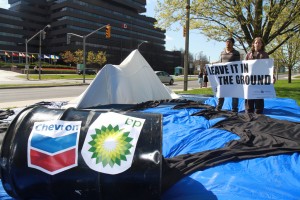The Council of Canadians along with Friends of the Earth, Norway, Greenpeace-Canada, IndigenousEnvironmental Network, REDOIL Network and others are sponsoring an international statement against Arctic offshore drilling.
Add your voice to the demand to stop Arctic offshore drilling by signing the statement here:
Leave it in the ground: Statement against Arctic offshore drilling.
The statement demonstrates international unity and solidarity in opposing Arctic offshore drilling.
The statement reads:
We, the undersigned, oppose offshore drilling in the Arctic.
Melting glaciers, sea ice and permafrost in the Arctic region is sending a clear warning signal that greenhouse gas emissions caused by dependence on fossil fuels has reached dangerous levels. The severity of the climate crisis means we will have to leave identified fossil fuel deposits in the ground.[i]
The devastating BP spill off the Gulf of Mexico has awakened our collective consciousness to the serious risks of offshore drilling. Evidence demonstrates that best practices will not always be followed and accidents will happen.[ii] Arctic conditions such as freezing temperatures, reduced visibility, seasonal ice and extreme weather all increase the probability and consequences of a spill.[iii]
Offshore drilling stands to have devastating impacts on fragile ice edge ecosystems upon which indigenous peoples and coastal communities rely for food security, economic, social and cultural needs.
We need to move away from fossil-fuel based economies through measures such as increased conservation, energy efficiency, renewable energy expansion, public transit and sustainable agriculture.
————
[i] Meinshausen, Malte et al. “Greenhouse-gas Emission Targets for Limiting Global Warming to 2C.”Nature 458. (2009 ): Web. 04 Feb 2011. <http://www.nature.com/nature/journal/v458/n7242/abs/nature08017.html>; Monbiot, George. “How Much Should we Leave in the Ground .” George Monbiot . 06 05 2009. Web. 14 Apr 2011. <http://www.monbiot.com/2009/05/06/how-much-should-we-leave-in-the-ground/>.
[ii] “Arctic Offshore Oil and Gas Guidelines.” Arctic Council, 2009. Web. 21 Feb 2011. <http://arctic-council.org/filearchive/Arctic%20Offhsore%20Oil%20and%20Gas%20Guidelines%202009.pdf>., p.8.
[iii] Simon Wilson et al. “Assessment 2007 Oil and Gas Activities in the Arctic – Effects and Potential Effects, Volume One.” Arctic Monitoring and Assessment Programme (AMAP), 2007. Web. 27 Feb 2011. <http://www.amap.no/oga/>, p. 212.



